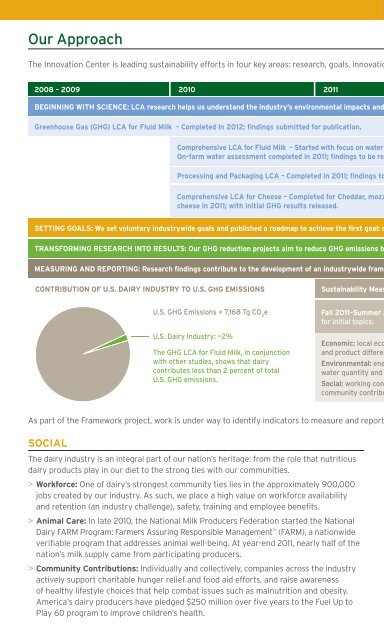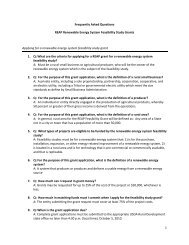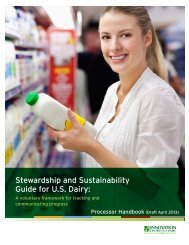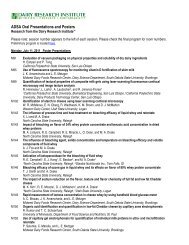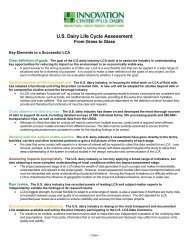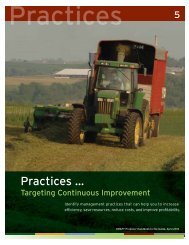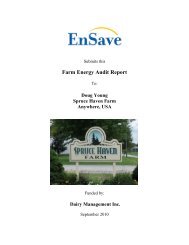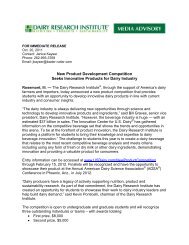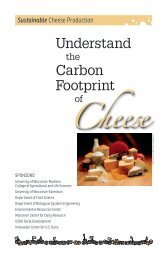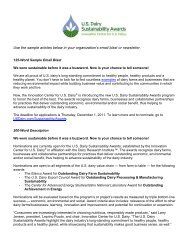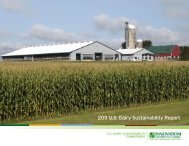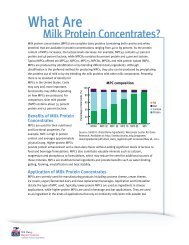2011 U.S. Dairy Sustainability Report Executive Summary
2011 U.S. Dairy Sustainability Report Executive Summary
2011 U.S. Dairy Sustainability Report Executive Summary
You also want an ePaper? Increase the reach of your titles
YUMPU automatically turns print PDFs into web optimized ePapers that Google loves.
Our Approach<br />
The Innovation Center is leading sustainability efforts in four key areas: research, goals, innovation projects, and measurement and reporting.<br />
2008 – 2009 2010 <strong>2011</strong> 2012 2013<br />
BEGINNING WITH SCIENCE: LCA research helps us understand the industry’s environmental impacts and prioritize improvement efforts across the dairy value chain.<br />
Greenhouse Gas (GHG) LCA for Fluid Milk – Completed in 2012; findings submitted for publication.<br />
GHG Results: 17.6 lbs. of carbon dioxide equivalents (CO 2<br />
e) per gallon of milk consumed.<br />
Comprehensive LCA for Fluid Milk – Started with focus on water with ongoing study of land use, nutrient cycles and other impacts<br />
On-farm water assessment completed in <strong>2011</strong>; findings to be released in 2012.<br />
Processing and Packaging LCA – Completed in <strong>2011</strong>; findings to be released in 2012.<br />
Comprehensive LCA for Cheese – Completed for Cheddar, mozzarella and natural<br />
cheese in <strong>2011</strong>; with initial GHG results released.<br />
GHG Results: Lbs. CO 2<br />
e per lb. of cheese consumed<br />
Cheddar<br />
8.7<br />
Mozzarella<br />
7.5<br />
Natural Cheese<br />
8.3<br />
SETTING GOALS: We set voluntary industrywide goals and published a roadmap to achieve the first goal: reduce GHG emissions for fluid milk by 25 percent by 2020.<br />
TRANSFORMING RESEARCH INTO RESULTS: Our GHG reduction projects aim to reduce GHG emissions by approximately 11 percent and deliver an estimated $238M in business value across the value chain.<br />
MEASURING AND REPORTING: Research findings contribute to the development of an industrywide framework to measure and report sustainability performance.<br />
CONTRIBUTION OF U.S. DAIRY INDUSTRY TO U.S. GHG EMISSIONS<br />
U.S. GHG Emissions = 7,168 Tg CO 2<br />
e<br />
U.S. <strong>Dairy</strong> Industry: ~2%<br />
The GHG LCA for Fluid Milk, in conjunction<br />
with other studies, shows that dairy<br />
contributes less than 2 percent of total<br />
U.S. GHG emissions.<br />
<strong>Sustainability</strong> Measurement and <strong>Report</strong>ing Framework for U.S. <strong>Dairy</strong> project launched.<br />
Fall <strong>2011</strong>–Summer 2012: Develop guiding principles; identify and define indicators<br />
for initial topics:<br />
Economic: local economic impacts<br />
and product differentiation<br />
Environmental: energy, GHG emissions,<br />
water quantity and quality<br />
Social: working conditions, animal care,<br />
community contributions<br />
Summer: public review of draft<br />
guiding principles and environmental<br />
indicators and metrics.<br />
Winter: public review of social and<br />
economic indicators; update principles<br />
and Framework.<br />
January: Submission of draft Framework<br />
to Innovation Center Board for approval.<br />
Topics for consideration after 2012:<br />
Economic: value across the supply<br />
chain, financials and others<br />
Environmental: waste, biodiversity/<br />
land use, crop production and others<br />
Social: food safety, health and nutrition,<br />
and others<br />
As part of the Framework project, work is under way to identify indicators to measure and report on the social and economic dimensions of the dairy industry.<br />
SOCIAL<br />
The dairy industry is an integral part of our nation’s heritage: from the role that nutritious<br />
dairy products play in our diet to the strong ties with our communities.<br />
> Workforce: One of dairy’s strongest community ties lies in the approximately 900,000<br />
jobs created by our industry. As such, we place a high value on workforce availability<br />
and retention (an industry challenge), safety, training and employee benefits.<br />
> Animal Care: In late 2010, the National Milk Producers Federation started the National<br />
<strong>Dairy</strong> FARM Program: Farmers Assuring Responsible Management (FARM), a nationwide<br />
verifiable program that addresses animal well-being. At year-end <strong>2011</strong>, nearly half of the<br />
nation’s milk supply came from participating producers.<br />
> Community Contributions: Individually and collectively, companies across the industry<br />
actively support charitable hunger relief and food aid efforts, and raise awareness<br />
of healthy lifestyle choices that help combat issues such as malnutrition and obesity.<br />
America’s dairy producers have pledged $250 million over five years to the Fuel Up to<br />
Play 60 program to improve children’s health.<br />
ECONOMIC<br />
<strong>Dairy</strong>’s supply chain generates economic benefits at the local, regional and national levels<br />
through employment, local tax revenues and purchases of products and services. Every<br />
dollar spent locally by a dairy producer creates a multiplier effect of more than two and a<br />
half times the original dollar spent.<br />
> The United States is the largest producer of cow’s milk in the world, and dairy is the<br />
fourth largest agricultural commodity in the U.S. <strong>Dairy</strong>’s on-farm revenues are $31.4<br />
billion, contributing 10 percent of total receipts from sales of agricultural commodities.<br />
> Farms and dairy processors operate throughout all 50 states.<br />
9.1 MILLION COWS<br />
ON MORE THAN<br />
53,000 FARMS<br />
PRODUCED<br />
192.8 BILLION<br />
POUNDS OF MILK<br />
1,200<br />
DAIRY PLANTS<br />
PRODUCED A<br />
VARIETY OF DAIRY<br />
PRODUCTS<br />
AMERICANS<br />
SPENT ~6%<br />
OF THEIR<br />
FOOD BUDGETS<br />
ON DAIRY


